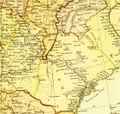Don (river)
The Don (Дон) is one of the major rivers of Russia. It starts in the town of Novomoskovsk 60 km southeast from Tula, southeast of Moscow, and flows for a distance of about 1,870 km (1,162 miles) to the Sea of Azov.
| Don (river) | |
|---|---|
| Mouth | Sea of Azov |
| Length | 1,870 km (1,162 mi) |
From its source, the river first flows southeast to Voronezh, then southwest to its mouth. The main city on the river is Rostov on Don, its main tributary, the Donets.
History
In antiquity, the river was seen as the border between Europe and Asia.[1] In the Hebrew Book of Jubilees, it is mentioned as being part of the border, beginning with its westernmost point up to its mouth, between the allotment of Japheth to the north and that of Shem to the south, sons of Noah. During the times of the old Scythians it was known in Greek as the Tanaïs, and has been a major trading route ever since.
Tanais appears in ancient Greek sources as the name of the river and of a city on it in the Maeotian marshes. The name derives however from Scythian (Iranian) Dānu "river", akin to modern Ossetic don "river".
At its easternmost point, the Don comes near the Volga, and the Volga-Don Canal (length ca. 105 km (65 miles)), connecting both rivers, has been a major waterway. The Khazar fortress of Sarkel used to dominate this point in the Middle Ages. This part of the river saw Operation Uranus, one of the turning points of the Second World War.
The Don has given its name to the Don Cossacks who settled the fertile valley of the river in the 16th and 17th centuries. In modern literature, the Don figures centrally in the works of Mikhail Sholokhov, a Cossack from the stanitsa of Veshenskaya.
Views of Don River
Don River near khutor Kalininsky in Rostov Oblast (photo 2002).
Don River, near Yelets
Don River in Rostov-on-Don
Map of 1882 showing the River basins of the Don and the Volga rivers
Don (river) Media
Source of the Don in Novomoskovsk, Tula Oblast
Footnotes
| Wikimedia Commons has media related to Lua error in Module:Commons_link at line 62: attempt to index field 'wikibase' (a nil value).. |
- ↑ Norman Davies (1997). Europe: A History. p. 8. ISBN 0-7126-6633-8.







